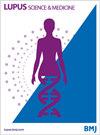Case series of anifrolumab for treatment of cutaneous lupus erythematosus and lupus-related mucocutaneous manifestations in patients with SLE
IF 3.7
2区 医学
Q1 RHEUMATOLOGY
引用次数: 0
Abstract
Objective To assess the efficacy of anifrolumab, a type-1 interferon receptor subunit-1 monoclonal antibody, in treating refractory cutaneous lupus erythematosus (CLE) and lupus non-specific mucocutaneous manifestations in patients with systemic lupus erythematosus (SLE). Methods A case series comprising four SLE patients with refractory CLE received anifrolumab (300mg) as add-on therapy. Medical history, serological markers and images were collected. Cutaneous Lupus Erythematosus Disease Area and Severity Index–Activity (CLASI-A) was assessed at baseline and post-treatment visits. Results Patient 1: Anifrolumab effectively treated refractory chronic cutaneous lupus erythematosus with lupus panniculitis and calcinosis cutis. Patient 2: Anifrolumab demonstrated rapid improvement in generalised discoid lupus, achieving a substantial reduction in CLASI-A from 40 to 8. Patient 3: Switching from belimumab to anifrolumab led to notable improvement in photosensitivity and tumid lupus. Patient 4: Anifrolumab effectively managed refractory subacute cutaneous lupus erythematosus, resulting in remarkable cutaneous improvement and successful tapering of prednisone and mycophenolate mofetil. Conclusion Anifrolumab demonstrates efficacy in treating refractory CLE subtypes and lupus non-specific mucocutaneous manifestations in SLE patients. Further studies are needed to establish response rates, optimal dosing, and long-term outcomes.阿尼洛单抗治疗系统性红斑狼疮患者皮肤红斑狼疮和狼疮相关粘膜表现的病例系列
目的 评估1型干扰素受体亚单位-1单克隆抗体阿尼夫单抗治疗系统性红斑狼疮(SLE)患者难治性皮肤红斑狼疮(CLE)和狼疮非特异性皮肤黏膜表现的疗效。方法 由四名患有难治性 CLE 的系统性红斑狼疮患者组成的病例系列接受了阿尼单抗(300 毫克)作为附加疗法。收集病史、血清学指标和图像。在基线和治疗后访视时对皮肤红斑狼疮疾病面积和严重程度指数-活动性(CLASI-A)进行评估。结果 患者1:阿尼单抗有效治疗了难治性慢性皮肤红斑狼疮伴狼疮性泛发炎和皮肤钙化症。患者 2:阿尼单抗能迅速改善全身性盘状狼疮,使 CLASI-A 从 40 显著降至 8。患者 3:从贝利姆单抗转用安非鲁单抗后,光敏性狼疮和瘤型狼疮得到明显改善。患者 4:阿尼单抗有效控制了难治性亚急性皮肤红斑狼疮,使皮肤症状显著改善,并成功减少了泼尼松和霉酚酸酯的用量。结论 Anifrolumab 对治疗系统性红斑狼疮患者难治性 CLE 亚型和狼疮非特异性皮肤黏膜表现具有疗效。还需要进一步的研究来确定反应率、最佳剂量和长期疗效。
本文章由计算机程序翻译,如有差异,请以英文原文为准。
求助全文
约1分钟内获得全文
求助全文
来源期刊

Lupus Science & Medicine
RHEUMATOLOGY-
CiteScore
5.30
自引率
7.70%
发文量
88
审稿时长
15 weeks
期刊介绍:
Lupus Science & Medicine is a global, peer reviewed, open access online journal that provides a central point for publication of basic, clinical, translational, and epidemiological studies of all aspects of lupus and related diseases. It is the first lupus-specific open access journal in the world and was developed in response to the need for a barrier-free forum for publication of groundbreaking studies in lupus. The journal publishes research on lupus from fields including, but not limited to: rheumatology, dermatology, nephrology, immunology, pediatrics, cardiology, hepatology, pulmonology, obstetrics and gynecology, and psychiatry.
 求助内容:
求助内容: 应助结果提醒方式:
应助结果提醒方式:


